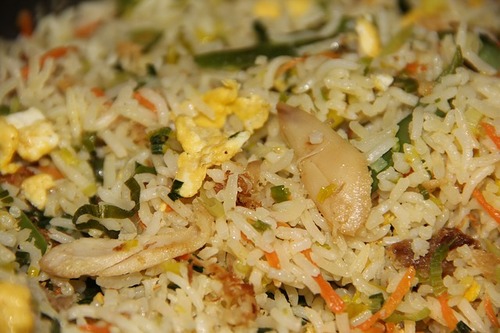Short answer
It depends on who’s making it. Homemade is always better than restaurant-made.
Recommended Alternative
Long answer
Fried rice is a staple food to a multitude of several cultures. And it's so delicious, even Americans have adopted Chinese restaurants and enjoy the food. Although it's a common and scrumptious menu item, it should not be a common part of your diet for too long.
Ingredients:
Before we break down the risks and the benefits, let's identify that not all fried rice recipes are the same, of course. It's always better to fry your own rice than to go to Panda Express or another restaurant to have it prepared for you—that way you know what is inside your food.
So we found a recipe off of Pinterest that looks relative simply. It includes the following ingredients:
- vegetable oil
- Uncooked instant rice
- Onion
- Green beans
- Egg
- Black pepper
- Soy sauce
Instant rice was used to make the cooking process much faster, but as we all know by now, most convenient foods are filled with preservatives and other chemicals to help with the quickness factor. If you're using the Minute brand of rice, you aren't in terrible shape. This brand of rice us around 200 calories for one cup and has 5 grams of protein. However, an ingredient to look out for is soy lecithin, which, as we have learned, has some cons to the name.
Eggs are optional, but they are a great source of vegetarian protein. Eggs by themselves aren't a threat to cholesterol level, contrary to popular belief. That's because the egg yolk contains dietary cholesterol, which, studies have shown, doesn't have much of an effect on our overall cholesterol level as opposed to fatty and greasy foods, according to Nutrition.org.
However, drenching these eggs in oil is a different story.
Onions and green beans are nutritious veggies, and seasonings like black pepper provide more nutritional benefits than sauces any day.
Ultimately, the only factor you need to look out for is the fat and oil. If you are making your own fried rice, you will have more control over how much cholesterol you are inviting into your dish. And you'll also have control over what type of oil you'll be consuming. Although our bodies do require a bit of fat, it doesn't mean we have to get the worst kind of fat. Oils that are filled with mono and polyunsaturated fats are better for you heart than those that are saturated and trans fats. Where does vegetable oil fall in?
Vegetable oil umbrellas a potpourri of vegetables: canola, olive, peanut, soybean, and even sunflower oil, and Heart.org says that it trumps margarine or butter in terms of nutrition. Typically when you're buying oil, look for the oils that contain less than 4 grams of saturated fats in each tablespoon.
And lastly, most Asian-styled rice are trademarked with the famous soy sauce. Soy sauce by itself is not very tasty, but as an essential element to fried rice, it sure adds a distinctive taste. However, with soy sauce, less is more. Your average soy sauce has about 879 milligrams of sodium in just one tablespoon. And according to Heart.org, we shouldn’t consume over 1,500 milligrams of sodium per day. To put this in perspective, two tablespoons of soy sauce is excessive. And an excessive amount of sodium affects our blood pressure, ultimately increasing the risk of heart disease.
From the ingredients above, fried rice isn’t that bad for you. However, you may be craving some Panda Express or Luan’s fried rice rather than homemade, and when you go out to eat at those restaurants, who knows how much soy sauce and oil they’re topping onto your rice?
Regardless overconsumption of anything increases your chances of multiple diseases. Depending on what is in your fried rice, you could be a fatty, high-caloric food. Fried foods, in general, shouldn’t be a staple for any diet unless your goal is high blood pressure and clogged arteries.
To lighten up fried rice:
- Use less oil
- Use brown rice
- Use less soy sauce
Possible short-term side effects
- headaches (from msg in soy sauce)
Possible long-term side effects
- weight gain
- hypertension
- heart disease
- stroke
Ingredients to be aware of
- soy sauce
- sodium
- saturated fat
- trans fat
- eggs (if vegan)
- various additives (store-bought or fast food varieties)

Benefits
- contains protein, grains, and vegetables in one dish
Healthier alternatives
- homemade fried rice
- brown rice
- black rice
Our Wellness Pick (what is this?)
RightRice Spanish
- Vegetable-based rice
- High in protein
- Vegan friendly
- Non-GMO
- Gluten-free
 Approved by
Approved by 















